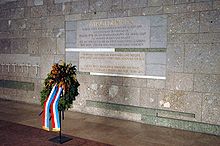Hall of Honor (Heilbronn)
The hall of honor in Heilbronn made of Heilbronn sandstone is located in the inner courtyard of the Heilbronn town hall . The memorial with Hiroshima mosaic by Karl Knappe , erected in the ruins of the old city archive , commemorates the dead of the Second World War and the victims of the Third Reich and is one of numerous important buildings in Heilbronn .
description
The building burned to the ground during the air raid on Heilbronn on December 4, 1944, and after the reconstruction of the town hall, which in future enclosed the ruin with its extensions built until 1963, was built according to plans by architect Dr. Ing.Rudolf Gabel from Heilbronn converted into a memorial.
A competition for the design of a worthy memorial was launched and 54 proposals were submitted. On December 5, 1960, the design by the Stuttgart artist G.-M. Klepsch was awarded first prize by a jury made up of architects from Heilbronn and representatives of the city administration. The impression made by the work was praised: “Very orderly drama, reminiscent of the terrible experience of the war. Apocalypical impression ” . The design showed a bright, simple hall in which a large wall sculpture was attached, plus three corresponding candlesticks - "The shape and arrangement of the candlesticks have a connection to the sculpture on the wall" . The wall sculpture showed elongated groups of figures in different orientations under a simple cross. The bronze casting was described in the Heilbronn voice (December 13, 1960):
"It may be that the abstracted bodies [...] shock the viewer right away, - but are they, crisscrossed and stacked in an apparently random arrangement, not [...] suitable for the terrible nature of that catastrophic night of the bombing and the senseless cruelty of war at all, to call into the imagination? "
Gabriele Holthuis describes the well-known design in the Sculpture City of Heilbronn , which showed stylized corpses in bronze:
“ [She] caused a sensation with a spectacular design [...] At a competition for a memorial in the Heilbronn Hall of Honor of the City Hall, she designed a wall relief [...] At that time, she had placed stylized corpses on top of and next to each other in bronze to keep the horrors of war permanently awake . "
This design, the other designs and the competition remained the subject of numerous disputes for a long time. Not the question of which design should be implemented, but also the question of whether the room was suitable for it was "hotly debated" . In December 1960, the models were exhibited in the shooting house, and the Heilbronn voice described the artists' designs in several editions. After a month the works were exhibited again, this time in the Kunstverein, and a public survey was carried out. Nevertheless, it was not possible to choose the winner or any other design from the competition. Mayor Paul Meyle justified this in a letter to the award winner as follows:
" In the hall of honor we should not only be surrounded by mourning, but also express the nonethelessness, the courage to live and the gratitude for having got away with life ."
For this reason, Professor Karl Knappe from Munich, who had not participated in the competition, was commissioned to design the hall. In a commemorative hour on the evening of December 4, 1963, the city of Heilbronn presented the hall of honor dedicated to the memory of the dead of the Second World War and the victims of the Third Reich. The text of the plaque, which in sober words gives a terrifying record of the rich harvest of deaths, reads:
" Three rows of white crosses, irregularly grouped on a wall in Nagelfluhstein, symbolize the deaths of the 3,435 fallen and missing from the war, the 7137 men, women and children who fell victim to the bombing of the city, and the 405 persecuted, who lost their lives for the sake of their race, their beliefs and their convictions. "
This was a poem by senior teacher Dr. Köhler added:
- In fire and fall,
- in dwindling and becoming,
- over coffins and cradles
- grace arches up her tent
- from the dead memory
- grow the will
- to work the good
- to serve the peace of the earth.
Until 1944 the building preserved memories of past generations through the archives, but today it serves as a silent reminder of war and violence.
Individual evidence
- ↑ a b Julius Fekete , Simon Haag, Adelheid Hanke, Daniela Naumann: Stadtkreis Heilbronn . (= Monument topography Federal Republic of Germany , cultural monuments in Baden-Württemberg, Volume I.5.). Theiss, Stuttgart 2007, ISBN 978-3-8062-1988-3 , pp. 118 .
- ^ Gabriele Holthuis: City of Sculptures Heilbronn . 1st edition. Heilbronn 1996, p. 77.
- ↑ Brunner (1993), p. 96
- ↑ a b c d Brunner (1993), p. 98.
- ↑ Brunner (1993), Figs. 130 and 130a, p. 97.
- ↑ quoted from: Brunner (1993), p. 98
- ^ Gabriele Holthuis: City of Sculptures Heilbronn . 1st edition. Heilbronn 1996, pp. 77-78.
- ^ Helmut Schmolz, Hubert Weckbach: Heilbronn: History and life of a city. Anton H. Konrad-Verlag, Weißenhorn 1973.
literature
- Dieter Brunner: Art in architecture in Hailbronn in the 50s. In: Andreas Pfeiffer (Ed.): Heilbronn and the art of the 50s. The art scene in Heilbronn in the 1950s. Situations from everyday life, traffic and architecture in Heilbronn in the 50s. (Heilbronn museum catalog, 43rd series Städtische Galerie). Harwalik, Reutlingen 1993, ISBN 3-921638-43-7 , pp. 90-105.
Web links
Coordinates: 49 ° 8 '34.3 " N , 9 ° 13' 7.7" E

